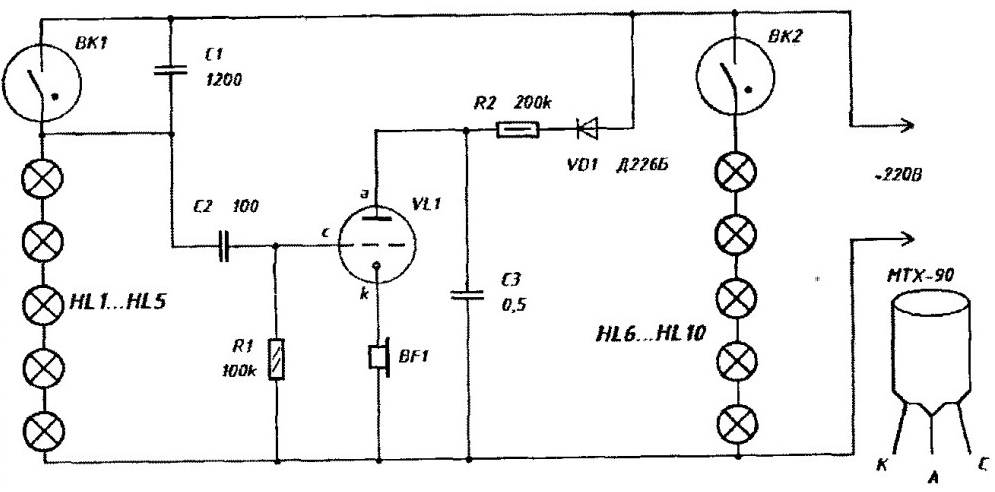Offer to your attention a rather unusual design. Its purpose is light and sound imitation fire or hearth of the fireplace. Shimmering flash garlands in combination with chaotic crackle create the illusion of a burning campfire.
The study is based on a widespread scheme include garlands of lamps consistently with the starter of the fluorescent light. As you know, the starter consists of casing, condenser and gas-filled lamp with two thermal switches. When a voltage equal to the voltage of occurrence of the electric discharge in the lamp is on, you receive a discharge through the gap between the contacts of the lamp. Using the starter current begins to flow.
In accordance with the Joule-Lenz law
Q=I2Rt
the amount of heat generated in the path of current flow depends on the resistance and time of the current action. During the discharge through the gas gap resistance will be great, as a consequence, the fan is warmed up and under the action temperature deformed so that touch each other. The discharge will stop, so as contacts are closed. The resistance of closed contacts are few and cool down. Time finding contacts in the closed state is determined by the time of their cool. After cooling the contacts open. If you re-energise, the process is repeated. When the starter motor in series with a garland of lamps, the frequency of their inclusion is sporadic.
This feature starter is used in the described simulator, which is shown in the figure.

(click to enlarge)
When included in the network of the positive half begin to charge the capacitor C3 through the resistor R2 and the diode VD1. To achieve on the capacitor C3 voltage the ignition of the thyratron VL1, C3 discharges through VL1 and a Cup BF1 - hear click. When contacts starter BK1 voltage at the lamps HL1...HL5 is increasing dramatically, they are lit. At the same time through integrating chain R1, C2 to the control electrode of thyratron VL1 is supplied to the positive the momentum can open the thyratron until the voltage on the anode reaches the ignition voltage of the thyratron.
Since the charging time of the capacitor C3 constant and the voltage across it increases with constant speed (sawtooth signal), then the energy transferred to BF1, is directly proportional to depends on the period of the pulses, opening VL1. Since the period of the starter random in nature, the duration and the volume of clicks in BF1 will also be to be accidental. More often than blink the lamp, the more often and will be quieter crackles conversely, the fewer outbreaks, the louder will be the clicks.
The establishment lies in the selection of the resistor R2 to obtain reasonable the volume of clicks BF1. The capacitance of the capacitor C1 in small change within the frequency switching BK1. The larger the capacitance C1, the lower the frequency. Optional in the schema, you can include another one or two garlands with starters, connecting in parallel BK1 HL1 and HL5...(BK2 and HL6...HL10).
Details: thyratron VL1 - Mat-90; all resistors MLT-0,5; capacitors C1, C2 of any type with voltage not lower than 400 V, the capacitor C3 with a working voltage not lower than 250 V; telephone earpiece TK-67 with a coil resistance of 60 Ohms. Lamp filament HL1...HL5 and HL6...HL10 - km 60-50 or other bulbs in total a voltage of 300 V. the Starter - any of the fluorescent light output 20...80 watts.
Author: S. Rychen, Sverdlovsk region, Pervouralsk






